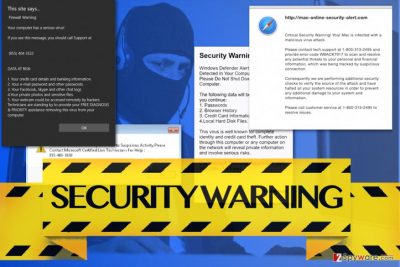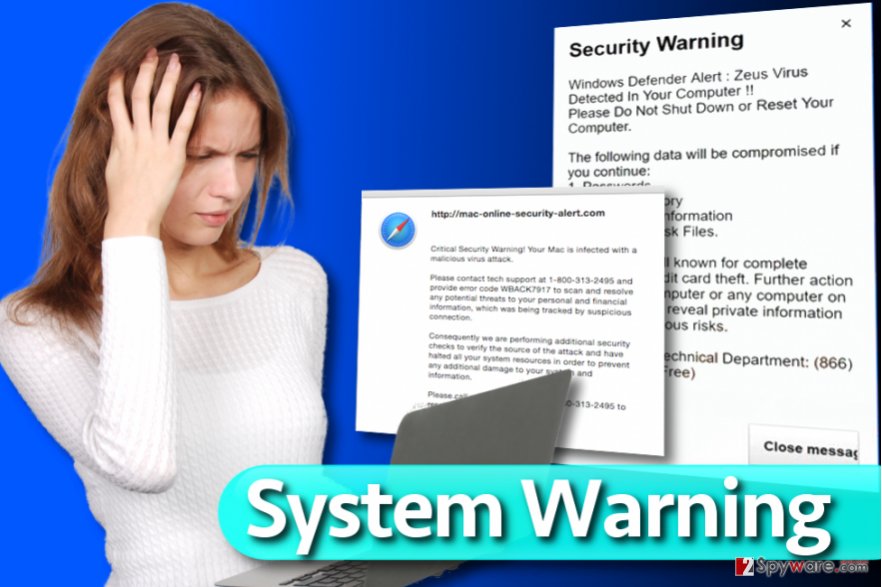Security Warning (Fake) (Removal Guide) - Aug 2017 update
Security Warning (Fake) Removal Guide
What is Security Warning (Fake)?
Security Warning (Fake) is a fake message from tech support scammers

“Security Warning” is a fraudulent alert that may appear on victim's computer screen. The message provided by the alert may state that victim's computer has been compromised by Zeus virus, hacked by criminals, or used for illegal activities. This scam is designed to scare the victim and encourage him/her to call technical support for help. Unfortunately, the number provided on the said alert belongs to tech support scammers[1].
The deceptive “Security Warning” error message is usually caused by a malware installed on victim's computer. It causes repetitious redirects to phishing websites which display the the bogus pop-up and usually play an audio message reading its contents loudly.
The fraudulent website might trigger never-ending pop-ups and prevent the victim from closing them. Obviously, urgent Security Warning removal is required to stop the process that initiates these unpleasant activities. The alert type might differ, but usually scammers use such lines to attract victim's attention:
- Windows Defender Alert : Zeus Virus Detected In Your Computer !!
- Firewall Warning: Your computer has a serious virus!
- Critical Security Warning! Your Mac is infected with a malicious virus attack.
- Security Warning : Suspicious Activity Found.
Security Warning (Fake) malware is related to OS Firewall software (OSFirewall.exe), which is a rogue and deceptive program that belongs to ‘malware’ category. To be more precise, it acts as a scareware type software, because once it slithers into victim’s computer system, it immediately starts to send frightening pop-ups that look like real system alerts.
These warnings claim that a suspicious and possibly malicious virus was found on your PC and that OS Firewall could not remove it automatically, so to save your computer, you need to call a number provided. Sounds ridiculous, right?
However, many computer users get cold feet when they see statements that their credit card information, login information, Facebook chat history, bank login details and Skype chat information are at risk.

Some facts about Security Warning scam:
- The malicious process that sends you these warnings is named OSFirewall.exe. You should not believe what this delusive program says to you.
- Do not fall for its intimidatory tactics and do not call the number provided (0-800-260-5674 or a different one). Otherwise, these frauds behind this fake tech support number might attempt to talk you into providing personal details, including banking information or just ask you some details about your computer that will help them to access it and take control over it.
- Plus, this scam tech support number may be a premium rate one, which means it will rip off a large sum from you for a single call.
Please, do not fall for the artifice of frauds[2], and do not let them take advantage of you. The good news is that you can stop these fake alerts for good by removing OS Firewall malware. We recommend you to remove Security Warning virus with a professional malware removal tool, for example, FortectIntego.
Protect your computer from tech support scam malware
Malware like OS Firewall can be spread in several different ways. According to ZonderVirus.nl[3], in most of the cases, the virus can be installed via fake software updates provided on high-risk websites on the web. We are sure you saw some fake proposals to install Java updates already.
You can identify scam offers to install software updates easily – they usually appear in intrusive pop-up windows or show up as ads or banners on untrustworthy web pages. Bypass such offers. You should install software updates only from verified and secure websites or from official developer’s site only.
What is more, OS Firewall threat can come in so-called bundled software packs, which can be downloaded from insecure download sites. To avoid installing dangerous or infectious programs, you have to check whether the software that you have downloaded has some additional applications attached to it or not. For that, opt for Custom or Advanced installation option.
If this configuration provides an extra window including a list of ‘recommended programs,’ it means you have downloaded a software pack. Therefore, you need to deselect the agreements to install these ‘recommended’ apps.
If you suspect that this rogue program has invaded your computer already, please navigate to page 2 to find an explanation how to banish it from your computer system.
Remove Security Warning (Fake) virus today
In case the suspicious security alerts have already started to annoy you, you should remove Security Warning virus as soon as possible. It is the only way to make these pop-ups disappear for good. To uninstall OS Firewall virus from your computer , consider using a professional malware removal software. Computer security experts recommend eliminating such malware programs automatically.
You can use one of the following programs that we recommend – FortectIntego (Windows OS) or Malwarebytes (Windows and Mac OS). Depending whether you use Mac or PC’s operating system, choose a suitable program, install it and run a system scan to find all potentially dangerous threats and remove them completely. Before you attempt to initiate Security Warning removal, prepare your PC for it using these guidelines.
Getting rid of Security Warning (Fake). Follow these steps
Manual removal using Safe Mode
Use the given guidelines to restart your PC in Safe Mode with Networking. In this mode, it will be much easier to find and remove Security Warning (fake) initiator using anti-malware software.
Important! →
Manual removal guide might be too complicated for regular computer users. It requires advanced IT knowledge to be performed correctly (if vital system files are removed or damaged, it might result in full Windows compromise), and it also might take hours to complete. Therefore, we highly advise using the automatic method provided above instead.
Step 1. Access Safe Mode with Networking
Manual malware removal should be best performed in the Safe Mode environment.
Windows 7 / Vista / XP
- Click Start > Shutdown > Restart > OK.
- When your computer becomes active, start pressing F8 button (if that does not work, try F2, F12, Del, etc. – it all depends on your motherboard model) multiple times until you see the Advanced Boot Options window.
- Select Safe Mode with Networking from the list.

Windows 10 / Windows 8
- Right-click on Start button and select Settings.

- Scroll down to pick Update & Security.

- On the left side of the window, pick Recovery.
- Now scroll down to find Advanced Startup section.
- Click Restart now.

- Select Troubleshoot.

- Go to Advanced options.

- Select Startup Settings.

- Press Restart.
- Now press 5 or click 5) Enable Safe Mode with Networking.

Step 2. Shut down suspicious processes
Windows Task Manager is a useful tool that shows all the processes running in the background. If malware is running a process, you need to shut it down:
- Press Ctrl + Shift + Esc on your keyboard to open Windows Task Manager.
- Click on More details.

- Scroll down to Background processes section, and look for anything suspicious.
- Right-click and select Open file location.

- Go back to the process, right-click and pick End Task.

- Delete the contents of the malicious folder.
Step 3. Check program Startup
- Press Ctrl + Shift + Esc on your keyboard to open Windows Task Manager.
- Go to Startup tab.
- Right-click on the suspicious program and pick Disable.

Step 4. Delete virus files
Malware-related files can be found in various places within your computer. Here are instructions that could help you find them:
- Type in Disk Cleanup in Windows search and press Enter.

- Select the drive you want to clean (C: is your main drive by default and is likely to be the one that has malicious files in).
- Scroll through the Files to delete list and select the following:
Temporary Internet Files
Downloads
Recycle Bin
Temporary files - Pick Clean up system files.

- You can also look for other malicious files hidden in the following folders (type these entries in Windows Search and press Enter):
%AppData%
%LocalAppData%
%ProgramData%
%WinDir%
After you are finished, reboot the PC in normal mode.
Remove Security Warning (Fake) using System Restore
-
Step 1: Reboot your computer to Safe Mode with Command Prompt
Windows 7 / Vista / XP- Click Start → Shutdown → Restart → OK.
- When your computer becomes active, start pressing F8 multiple times until you see the Advanced Boot Options window.
-
Select Command Prompt from the list

Windows 10 / Windows 8- Press the Power button at the Windows login screen. Now press and hold Shift, which is on your keyboard, and click Restart..
- Now select Troubleshoot → Advanced options → Startup Settings and finally press Restart.
-
Once your computer becomes active, select Enable Safe Mode with Command Prompt in Startup Settings window.

-
Step 2: Restore your system files and settings
-
Once the Command Prompt window shows up, enter cd restore and click Enter.

-
Now type rstrui.exe and press Enter again..

-
When a new window shows up, click Next and select your restore point that is prior the infiltration of Security Warning (Fake). After doing that, click Next.


-
Now click Yes to start system restore.

-
Once the Command Prompt window shows up, enter cd restore and click Enter.
Finally, you should always think about the protection of crypto-ransomwares. In order to protect your computer from Security Warning (Fake) and other ransomwares, use a reputable anti-spyware, such as FortectIntego, SpyHunter 5Combo Cleaner or Malwarebytes
How to prevent from getting malware
Stream videos without limitations, no matter where you are
There are multiple parties that could find out almost anything about you by checking your online activity. While this is highly unlikely, advertisers and tech companies are constantly tracking you online. The first step to privacy should be a secure browser that focuses on tracker reduction to a minimum.
Even if you employ a secure browser, you will not be able to access websites that are restricted due to local government laws or other reasons. In other words, you may not be able to stream Disney+ or US-based Netflix in some countries. To bypass these restrictions, you can employ a powerful Private Internet Access VPN, which provides dedicated servers for torrenting and streaming, not slowing you down in the process.
Data backups are important – recover your lost files
Ransomware is one of the biggest threats to personal data. Once it is executed on a machine, it launches a sophisticated encryption algorithm that locks all your files, although it does not destroy them. The most common misconception is that anti-malware software can return files to their previous states. This is not true, however, and data remains locked after the malicious payload is deleted.
While regular data backups are the only secure method to recover your files after a ransomware attack, tools such as Data Recovery Pro can also be effective and restore at least some of your lost data.
- ^ Tech support scams. Microsoft. Windows Defender Security Intelligence .
- ^ Jérôme Segura. Tech support scams and Google Chrome tricks. Malwarebytes Blog. The Security Blog.
- ^ Zondervirus. ZonderVirus. Malware Removal Guides.





















